by Eric Meier
When attempting to identify a wood sample, it’s important to keep in mind the limitations and obstacles that are present in our task. Before starting, please have a look at The Truth Behind Wood Identification to approach the task in a proper mindset; I consider the linked article to be required reading for all those visiting my site with the intent of identifying wood.
1. Confirm it is actually solid wood.
Before proceeding too much farther into the remaining steps, it’s first necessary to confirm that the material in question is actually a solid piece of wood, and not a man-made composite or piece of plastic made to imitate wood.
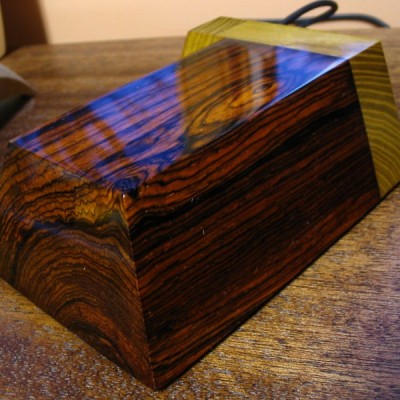
Can you see the end-grain?
Manufactured wood such as MDF, OSB, and particleboard all have a distinct look that is—in nearly all cases—easily distinguishable from the endgrain of real wood. Look for growth rings—formed by the yearly growth of a tree—which will be a dead-giveaway that the wood sample in question is a solid, genuine chunk of wood taken from a tree.
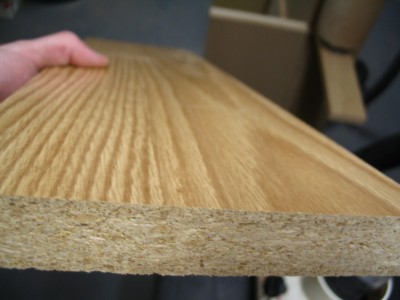
Is it veneered?
If you see a large panel that has a repeating grain pattern, it may be a veneer. In such cases, a very thin layer of real wood is peeled from a tree and attached to a substrate; sometimes the veneer can be one continuous repeating piece because it is rotary-sliced to shave off the veneer layer as the tree trunk is spun by machines. Assuming it is a real wood veneer with a distinct grain and texture—and not merely a piece of printed plastic—you may still be able to identify the outer veneer wood in question, but you should still realize that is it only a veneer and not a solid piece of wood.
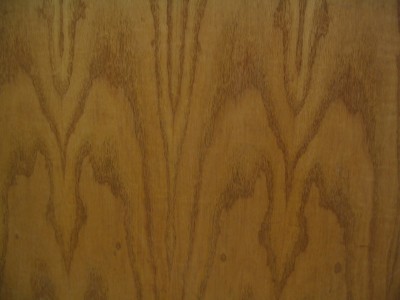
Is it painted or printed to look like wood?
Many times, especially on medium to large-sized flat panels for furniture, a piece of particleboard or MDF is either laminated with a piece of wood-colored plastic, or simply painted to look like wood grain. Many of today’s interior hardwood flooring planks are good examples of these pseudo-wood products: they are essentially a man-made material made of sawdust, glues, resins, and durable plastics.
2. Look at the color.
Some questions to immediately ask yourself:
Is the color of the wood natural, or is it stained?
If there is even a chance that the color isn’t natural, the odds are increased that the entire effort of identifying the wood will be in vain.
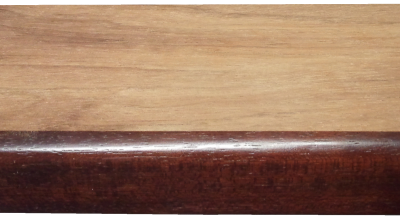
Is it weathered or have a patina?
Many woods, when left outside in the elements, tend to turn a bland gray color. Also, even interior wood also takes on a patina as it ages: some woods get darker, or redder, and some even get lighter or lose their color; but for the most part, wood tends to darken with age.
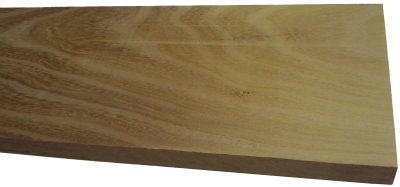
Is it possible to sand or plane the board to see the natural raw color of the wood?
The most predictable baseline to use when identifying wood is in a freshly sanded state. This eliminates the chances of a stain or natural aging skewing the color diagnosis of the wood.
3. Observe the wood grain.
If the wood is unfinished, then look at the texture of the grain. Ask yourself these questions:
Does the wood have an open, porous texture?
Most softwoods will be almost perfectly smooth with no grain indentations, while many common hardwoods have an open pore structure, such as oak or mahogany; though there are some hardwoods that are also smooth to the touch, such as maple.
Can you tell if the wood is quartersawn or plainsawn?
By observing the grain patterns, many times you can tell how the board was cut from the tree. Some wood species have dramatically different grain patterns from plainsawn to quartersawn surfaces. For instance, on their quartersawn surfaces, lacewood has large lace patterns, oak has flecks, and maple has the characteristic “butcher block” appearance.
Is there any figure or unusual characteristics, such as sapwood, curly or wild grain, burl/knots, etc.?
Some species of wood have figure that is much more common than in other species: for example, curly figure is fairly common in soft maple, and the curls are usually well-pronounced and close together. Yet when birch or cherry has a curly grain, it is more often much less pronounced, and the curls are spaced farther apart.
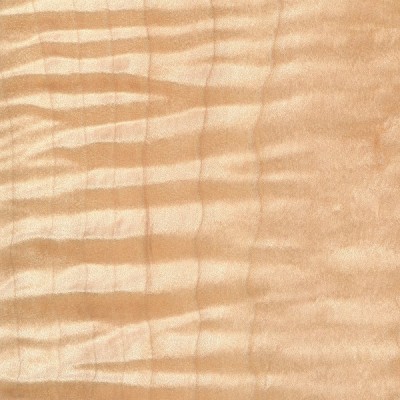
4. Consider the weight and hardness of the wood.
If it’s possible, pick the piece of wood up and get a sense of its weight, and compare it to other known wood species. Try gouging the edge with your fingernail to get a sense of its hardness. If you have a scale, you can take measurements of the length, width, and thickness of the wood, and combine them to find the density of the wood. This can be helpful to compare to other density readings found in the database. When examining the wood in question, compare it to other known wood species, and ask yourself these questions:
Is the wood dry?
Wood from freshly felled trees, or wood that has been stored in an extremely humid environment will have very high moisture contents. In some freshly sawn pieces, moisture could account for over half of the wood’s total weight! Likewise, wood that has been stored in extremely dry conditions of less than 25% relative humidity will most likely feel lighter than average.
How does the wood’s weight compare to other species?
Taking into account the size of the board, how does its weight compare to other benchmark woods? Is it heavier than oak? Is it lighter than pine? Look at the weight numbers for a few wood species that are close to yours, and get a ballpark estimate of its weight.
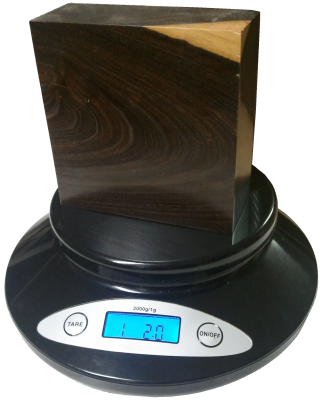
How hard is the wood?
Obviously softwoods will tend to be softer than hardwoods, but try to get a sense of how it compares to other known woods. Density and hardness are closely related, so if the wood is heavy, it will most likely be hard too. If the wood is a part of a finished item that you can’t adequately weigh, you might be able to test the hardness by gouging it in an inconspicuous area. Also, if it is used in a piece of furniture, such as a tabletop, a general idea of its hardness can be assessed by the number and depth of the gouges/dings in the piece given its age and use. A tabletop made of pine will have much deeper dents than a tabletop made of Oak. Additionally, you can always try the “fingernail test” as a rough hardness indicator: find a crisp edge of the wood, and with your fingernail try to push in as hard as you can and see if you’re able to make a dent in the wood.
5. Consider its history.
Many times we forget common sense and logic when attempting to identify wood. If you’ve got a piece of Amish furniture from Pennsylvania, chances are more likely that the wood will be made of something like black walnut or cherry, and not African wenge or jatoba. You might call it “wood profiling,” but sometimes it can pay to be a little prejudiced when it comes to wood identification. Some common-sense questions to ask yourself when trying to identify a piece of wood:
Where did it come from?
Knowing as much as you can about the source of the wood—even the smallest details—can be helpful. If the wood came from a wood pile or a lumber mill where all the pieces were from trees processed locally, then the potential species are immediately limited. If the wood came from a builder of antique furniture, or a boat-builder, or a trim carpenter: each of these occupations will tend to use certain species of woods much more often than others, making a logical guess much simpler.
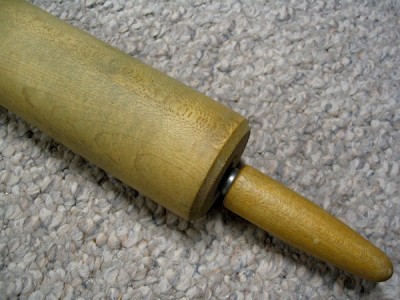
How old is it?
As with the wood’s source, its age will also help in identification purposes. Not only will it help to determine if the wood should have developed a natural patina, but it will also suggest certain species which were more prevalent at different times in history. For instance, many acoustic guitars made before the 1990s have featured Brazilian rosewood backs/sides, yet due to CITES restrictions placed upon that species, East Indian rosewood became a much more common species on newer guitars. (And this is a continuing shift as newer replacements are sought for rosewoods altogether.)
How large is the piece of wood?
Some species of trees are typically very small—some are even considered shrubs—while others get quite large. For instance, if you see a large panel or section of wood that’s entirely black, chances are it’s either painted, dyed, or stained: Gaboon ebony and related species are typically very small and very expensive.
What is the wood’s intended use?
Simply knowing what the wood was intended for—when considered in conjunction with where it came from and how old it is—can give you many clues to help identify it. In some applications, certain wood species are used much more frequently than others, so that you can make an educated guess as to the species of the wood based upon the application where it was used. For instance, in the United States: many older houses with solid hardwood floors have commonly used either red oak or hard maple; many antique furniture pieces have featured quartersawn white oak; many violins have spruce tops; many closet items used aromatic red cedar, and so forth. While it’s not a 100% guarantee, “profiling” the wood in question will help reduce the number of possible suspects, and aid in deducing the correct species.
6. Find the X-Factor.
Sometimes, after all the normal characteristics of a sample have been considered, the identity of the wood in question is still not apparent. In these instances—particularly in situations where a sample has been narrowed down to only a few possible remaining choices—it’s sometimes helpful to bring in specialized tests and other narrower means of identification.
The following techniques and recommendations don’t necessarily have a wide application in initially sorting out wood species and eliminating large swaths of wood species, but will most likely be of use only as a final step in special identification circumstances.
Odor
Believe it or not, freshly machined wood can have a very identifiable scent. When your eyes and hands can’t quite get a definitive answer, sometimes your nose can. Assuming there is no stain, finish, or preservative on or in the wood, quickly sand, saw, or otherwise machine a section of the wood in question, and take a whiff of the aroma.
Although new scents can be very difficult to express in words, many times the scent of an unknown wood may be similar to other known scents. For instance, rosewoods (Dalbergia spp.) are so named for their characteristic odor that is reminiscent of roses. Although difficult to directly communicate, with enough firsthand experience scents can become a memorable and powerful means of wood identification.
Fluorescence
While certain woods can appear basically identical to one another under normal lighting conditions, when exposed to certain wavelengths—such as those found in blacklights—the wood will absorb and emit light in a different (visible) wavelength. This phenomenon is known as fluorescence, and certain woods can be distinguished by the presence or absence of their fluorescent qualities. See the article Fluorescence: A Secret Weapon in Wood Identification for more information.
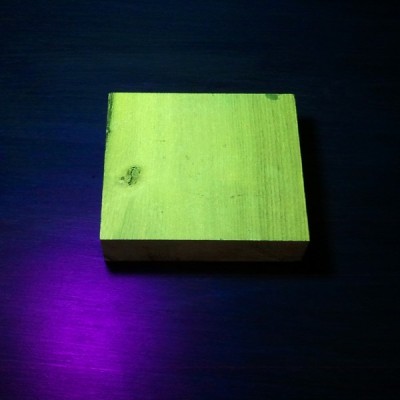
Chemical Testing
There are only a small number of chemical tests regularly used on wood, most of which are very specialized and were developed to help distinguish easily confused species with one another. They work by detecting differences in the composition of heartwood extractives. A chemical substance (called a reagent) is usually dissolved in water and applied to the wood surface: the surface is then observed for any type of chemical reaction (and accompanying color change) that may occur. Two of the most useful are the tests that are meant to separate Red and White Oak, and Red and Hard Maple.
Heartwood Extractives Leachability
Sometimes a wood species will have heartwood extractives that will be readily leachable in water and capable of conspicuously tinting a solution of water a specific color. For instance, the heartwood extractives contained in osage orange (Maclura pomifera) contain a yellowish-brown dye that is soluble in water. (This can sometimes be observed anecdotally when the wood is glued with a water-based adhesive: the glue’s squeeze-out is an unusually vibrant yellow.)
In a simple water extract color test, wood shavings are mixed with water in a vial, test tube, or other suitably small container, and the color of the water is observed after a few minutes. If the heartwood extractives are leachable by water, then a corresponding color change should quickly occur.
In addition to osage orange (Maclura pomifera), merbau (Intsia spp.), and rengas (Gluta spp. and Melanorrhoea spp.) are also noted for their readily leachable heartwood extractives. Because this property is quite uncommon, it can serve to quickly differentiate these woods from other lookalikes.
7. Look at the endgrain.
Perhaps no other technique for accurate identification of wood is as helpful and conclusive as the magnified examination of the endgrain. Frequently, it brings the identification process from a mostly intuitive, unscientific process into a predictable, repeatable, and reliable procedure.
Looking at the endgrain with a magnifier shouldn’t be a mystifying or esoteric art. In many cases, it’s nearly as simple as examining small newsprint under a magnifying glass. There are three components necessary to reap the full benefits contained in the endgrain:
I. A prepared surface.
When working with wood in most capacities, it becomes quickly apparent that endgrain surfaces are not nearly as cooperative or as easily worked as face grain surfaces. However, in this case, it is absolutely critical that a clear and refined endgrain surface is obtained.
For a quick glance of a softwood sample, a very sharp knife or razor blade can be used to take a fresh slice from the endgrain. However, in many denser species, especially in tropical hardwoods, one of the best ways to obtain a clear endgrain view is through diligent sanding. It’s usually best to begin with a relatively smooth saw cut (as from a fine-toothed miter saw blade) and proceed through the grits, starting at around 100, and working up to at least 220 or 320 grit, preferably higher for the cleanest view.
II. The right magnifier.
It need not be expensive, but whatever tool is used to view the endgrain should have adequate magnifying power. In most instances, 10x magnification is ideal, however, anything within the range of 8 to 15x magnification should be suitable for endgrain viewing. (Standard magnifying glasses are typically in the range of 2 to 4x magnification.)
These stronger magnifiers, sometimes called loupes, usually have a smaller viewing area than standard magnifying glasses. Fancier models—with built in lights, or larger viewing surfaces—are available at a premium; but the most basic models are usually only a few dollars.
III. A trained eye.
The third element that constitutes a proper endgrain examination is simply knowing what to look for. In analyzing the patterns, colors, shapes, and spacing of the various anatomical features, there is a veritable storehouse of information within the endgrain—all waiting to be unlocked. Yet, if these elements have not been pointed out and learned, the array of features will simply seem like an unintelligible jumble. The discipline of recognizing anatomical endgrain features is not easily summed up in a few sentences or even a few paragraphs, but it is nonetheless critical to the identification process. To this end, an in-depth look should be given to the various categories, divisions, and elements that constitute endgrain wood identification on the macroscopic level. (In this regard, macroscopic denotes what can be seen with a low-powered, 10x hand lens—without the aid of a microscope—rather than simply what can be seen with the naked eye.) Because the anatomy between softwoods and hardwoods is so divergent, each will be considered and examined separately:Still stumped?
If you have a mysterious piece of wood that you’d like identified, you’ve got a few options for next steps:USDA’s Forest Products Laboratory
You can mail your physical wood samples to the Center for Wood Anatomy Research.
Pros:
- Free
- Professional wood identification
Cons:
- Only available to US citizens
- Slow turnaround times (up to a month or more)
- Limited to three IDs per year
See their Wood ID Factsheet for more info.
Alden Identification Service
You can mail your physical wood samples (even small sections taken from antiques) to Alden Identification Service.
Pros:
- Professional wood identification
- Faster turnaround times (ranging from a few days to a week or two)
Cons:
- Paid service
See their ordering page for more info. (Note that Harry Alden has written several books while at USDA, including both Hardwoods and Softwoods of North America.)
Ask for help online
If the wood ID is merely a curiosity, or non-critical, you can post pictures of the wood in question.
Pros:
- Free
- No need to send physical samples
Cons:
- Greatly limited by the quality of the pictures provided
- Extra work usually required to get adequate clarity in photos
See article of Common US Hardwoods to help find the most commonly used woods.
Get the hard copy
 If you’re interested in getting all that makes The Wood Database unique distilled into a single, real-world resource, there’s the book that’s based on the website—the Amazon.com best-seller, WOOD! Identifying and Using Hundreds of Woods Worldwide. It contains many of the most popular articles found on this website, as well as hundreds of wood profiles—laid out with the same clarity and convenience of the website—packaged in a shop-friendly hardcover book.
If you’re interested in getting all that makes The Wood Database unique distilled into a single, real-world resource, there’s the book that’s based on the website—the Amazon.com best-seller, WOOD! Identifying and Using Hundreds of Woods Worldwide. It contains many of the most popular articles found on this website, as well as hundreds of wood profiles—laid out with the same clarity and convenience of the website—packaged in a shop-friendly hardcover book. 


Why I will no longer be replying to every wood ID request I’ve replied to literally thousands of wood ID requests on this site over the past 13+ years, but as the site’s popularity has grown, so has the time demands for ID on a daily basis. (Contrary to what some may seem to think, I am not some all-knowing wood wizard that can instantly ID your wood. It can actually take me a long time to sift through a lot of different resources.) Over the past few years, my backlog of pending wood species to be added to the… Read more »
Can you help me identify this wood by the end grain
Please attach a picture.
Any ideas on what this is? Ovangkol? Zebrano?
Can you get a shot of the endgrain? It might be rengas.
Totally! As best I can lol
I can’t even describe the smell… when it burns it’s like oak, but it has a… “chocolatey” smell after being cut…
Endgrain is still a bit rough, but it still points toward rengas. https://www.wood-database.com/rengas/
What is this wood
That looks like a very dense piece of some sort of hard pine species. I’m not sure what might be common in Israel, but there’s a large proportion of darker latewood present, so that would indicate that it’s a pretty dense piece of pine.
Eric, thank you for your answer.
I also suppose it is like or some of hard pine species, may be SITKA SPRUCE type of wood.
Is this cherry?
I can’t tell conclusively from those pics, but superficially it doesn’t look to be cherry. If you could strip off all the old finish and get a picture of the raw wood, I could get a better idea.
Here’s a better picture of the arm where I card scraped off the old finish. I will post three more close ups of the seat
No, that doesn’t look like cherry to me. It looks like a species with larger pores than cherry. Do you think it was something native to the midwest? If you can get a nice clean shot of the endgrain somewhere on the piece, I might be able to tell more.
Close up of seat
This is an old window from a historic house in Palm Beach, FL. Can you please help me identify this specie?
It looks like an old growth pine, but not the hard yellow pine variety, but something softer. Possibly something like Eastern white pine. https://www.wood-database.com/eastern-white-pine/
This wood is pretty heavy and hard to sand, I don’t think it’s pine.
What would be your next guess?
This is the endgrain picture. Can you please confirm the specie?
Not sure on the species, but it is a softwood of some sort. I believe I can see small resin canal groupings, so it could possibly be spruce, otherwise larch and douglas fir also have resin canals in small groups. Otherwise, there may be more resin canals present, but I just can’t see them in the picture; if so, then it would be a species of pine.
Hello, I want to buy this table however I’m not sure what type of wood it is. Can someone help me out?
Very hard to say, but based on your location in UAE, it could possibly be sissoo or sheesham wood. https://www.wood-database.com/sissoo/
Or, it could be something completely different! Would need a clear closeup view of the endgrain to tell more.
Hi Eric,
Thank you for your work. I’d like to purchase a copy of your book, but Amazon doesn’t provide edition details. Is the book on Amazon your 2nd edition? Thanks
-P.S. I attempted to send a message via the About Tab, but had no luck. The send icon just kept spinning.
Currently, it’s actually the fifth printing, done in June 2020. I don’t have any control over my Amazon listing, so kind of frustrating that I can’t update the info.
Ok, thanks Eric. Looking forward to the book!
Hi. I am refinishing a wood slat bench with wrought iron ends.
Any idea what wood this may be? One side is sanded and the other the original finish.
Best regards,
Brian
It doesn’t look like anything native to the US, at least not at first glance. Any chance you could get a close up shot of the endgrain?
Eric, thanks for your response. I hope these help.
The end grain is still too rough to make out very many details, but it looks like a tropical hardwood. To me, the closest match would be ramin. https://www.wood-database.com/ramin/
Eric, thanks for your help and time.
Hi. This is a bagpipe bellows from the North of England and nobody can identify the wood – not typical at all for this purpose. Made about 20 years ago and the wood is sanded and polished, not stained. Could have been repurposed? or have been brought from another country?
That grain pattern is sometimes called quilt or blister, and it’s most commonly seen on maple. Most of it in North America comes from bigleaf maple on the West Coast. It’s possible that there was some figured wood found locally in England.
Many thanks!
Hi I picked up this table at a goodwill for 10$ had some scarring to the top center piece and the dark stain I think did it an injustice. I’m still green around the ears when it comes to wood. Any idea what kind of wood this might be?
Well, at the very least I would say it appears mahogany-like. Though the drawer sides look like they are red oak, probably just an oak veneer plywood, not too uncommon for drawers.
This is advertised as oak but looks piney to me… any clues?
I agree, looks like a softwood like pine. The growth rings on oak are made up of hollow tube-like structures (pores) while pine’s growth rings are denser latewood material. The picture looks like the latter.
Thank you
I have had this piece for years , Here is a pic of the grain. Can you help me identify please. Thank you
This is the underside of an old drop leaf table. The slab is one piece, not a series of boards. It is 21×52 and I began to sand off the finish to try to ID the wood. Just found your site and thought I’d ask. Thanks for any help
I can’t tell from that pic, sorry. Maybe another, closer shot of thee sanded grain, and one that’s further out to see the broader patterning?
This is a dresser I refinished from when I was a baby. It is veneer and was very blonde when sanded it down. I did a light torch finish to bring out the grain. I want to make some night stands to match (as close as I can). Can you tell what kind of wood pattern this may be?
The grain pattern is sometimes called “cathedral” grain, and it can occur in nearly all wood species. It’s simply the result of the tree being cut up flat sawn. https://www.wood-database.com/wood-articles/what-is-wood/#elementor-toc__heading-anchor-4
Section was found in an old barn, northeast Ohio. Looking to find a matching piece for a project, but not sure what type of wood I’m dealing with. Thanks in advance!
Can you get a closer shot of the grain? I can’t make out enough detail from that distance.
Hopefully these help. Thinking maybe cherry?
Can you help me identify this Barnwood ? Some reddish hues , Ohio barn 1800s?
It looks like an old growth softwood of some sort. Just about any softwood that’s that old will be of decent quality, and worthy of being reclaimed. It may be a species of pine or fir. It doesn’t look like any of the really dense species of softwood like southern yellow pine or Douglas fir.
Hi. Anyone able to tell what this wood is please? I’m in Ireland. It’s an antique chest of drawers – at least 40 years old. Was quite badly marked so I’ve sanded down these two drawers so far. No idea – thought it might be teak, now thinking oak…. ?????
It looks like a hardwood species of some sort, though it lacks ray flecks which rules out oak. Teak is a real possibility, it tends to have a leather-like scent when being sanded. I’m not familiar enough with native Irish hardwoods to know what would’ve been commonly used there, but some other possibilities might include elm or sweet chestnut.
I’d like to veneer a table top, where I sanded thru the veneer. Attached is a picture of the untouched table leaf. Please give me an opinion of what type of wood I should purchase. I want the wood color in the middle of the leaf, not the edge.
Hard to tell species, as it may possibly be stained. I think you’d be better off looking at single veneer sheets of any wood species that has a similar grain pattern and spacing, and use stain to match the color.
Would anyone be able to tell me what type of wood this is? We are looking to sell this table.
I can’t tell from the pics, it has been stained a much darker color.
I’m tearing out carpet on the stairs of my new home built in 1865… I found these treads on the stairs… original… either yellow poplar or walnut according to the local historical council… doesn’t smell like walnut to me… difficult to sand but beautiful once sanded… help?
If you are sure that it is supposed to be either yellow poplar or walnut, I’d say yellow poplar. It does look like a diffuse porous hardwood. And perhaps give the age of the wood, it has darkened a bit over time.
Hello Eric,
I was hoping you could help me identify this wood type. I acquired approximate 10 slabs of this wood from an old gentleman nextdoor. There about 18-20″ x 36″ x 1 3/4″.
It looks king of like black walnut to me but not sure. Old guy I got it from couldn’t remember.
I want to make a solid body electric guitar out of a piece of it.
Thank you very much
Jerry Meeuwse
It’s not black walnut. From the endgrain, it looks like a species of mesquite.
I’m feeling really stupid! For the life of me I can’t remember what wood this is. Sucks to get old. leopard wood ? great website!
Yes, that very much looks like leopardwood to me.
thank you for the quick reply…
Hi, can anyone please tell me what kind of wood this is? It is a turned tall cylinder shaped container with a wooden lid. Some have suggested is is a humidor. The original owner said it has a smoke smell to it. Thank you!
Hard to tell if that is even a natural wood color, or if it’s been stained. Superficially, the grain reminds me of sapele. Can’t tell from the pics though.
Any ideas that this is? House is in very small town in Eastern Washington. Built in 1950
That is some of the tightest grain I’ve ever seen in flooring. Ordindiarily I’d guess southern yellow pine, but based on your location, I’d say it’s some very nice, old-growth, quartersawn Douglas fir.
Thank you so much. Do you think it’s worth refinishing?
Yes, if it were me, I’d have them refinished.
I have these three pieces of burl I acquired them 15 years and was told they where in the same house for at least 40 years really stumped on what kind of wood this and age?help!!
Possibly a black walnut burl.
What kind of wood is this cutting board?
Can’t tell for sure from the pics, but hickory or pecan might be a possibility.
What kind of wood is this?
I can’t tell from the picture. Where are you located, or what region of the world did this come from? Can you get a closer picture of the grain?
Can you tell what these 2 types off wood are? The darker i believe to be pine and the lighter maple. Am I correct? Thanks
Yes, it looks like southern yellow pine on the left, and probably maple on the right, though birch is also a possibility.
Forgot to post pic.
The two strips on right are redwood. I don’t know what the bulk of this is though. I thought it was redwood. Is it Cedar?
Is there a strong odor when sanding it? If so, it’s probably western red cedar.
Thanks. I hadn’t noticed an odor. I’ll be more cognitive of that as I sand this weekend. I just Googled western red cedar. It definitely looks like a match. Thanks again.
I would only consider it a match if there is a strong odor. If little to no odor, then it’s almost certainly not cedar, but another softwood species.
Can you tell me what type wood this is..Thanks
I can’t tell from the pic, but it appears to have a pretty wild grain pattern. One wood that I sometimes see with similar wild grain is mango. Or it could possibly be some kind of Albizia species or related wood, such as monkeypod.
Hiya, just trying to up cycle this old chest of drawers. I have sanded two drawer fronts but can’t tell what the wood is? I am in uk and think it might be ‘utility’ furniture from just after the war?
It appears to be solid oak, and given your location, it’s probably English oak (Quercus robur). The simplicity of the design and solid wood construction makes it a great candidate for refinishing.
Any thoughts on what this is?
I can’t tell for certain for the pic, but I can say from the pattern that the top is veneered. Superficially, the color and grain look closest to black cherry, but I can’t say that conclusively.
Can you help me identify the wood of this flemish painting from the xviii century? Thanks
Eugénie
Ordinarily, it would be almost impossible to ID wood from a picture like this, but in this case, the very distinct ray patterns of oak can be seen through even centuries of aging. I’m not sure what species of oak would be common in that area, but it looks to be some type of oak (Quercus genus).
Hey! thanks for the useful site! can you help me with wood identification? grows in Cambodia. locals call him Pchek kondajn
Looks like some nice stuff. Unfortunately I don’t know much about Cambodian woods. I’d try to ask around and get a few different names of the wood in different languages and see if one of them can be paired up with a scientific name. Googling in the language (and actual script) of the tree name can usually bring up a foreign-language wikipedia article or something to get the scientific name.
We recently moved from Virginia to Istanbul. Two weeks ago ago we walked into a small furniture shop and saw this slab hanging from the wall. It’s about 4″ thick and the gaps are filled with resin (aprox 50″ x 90″) I was struck by the tight grain and knobby edges. We bought the slab almost immediately. The seller is from Syria and he doesn’t speak any English. Do you have any idea what we bought?
A friend just told me that it looks like Mappa Burl (Black Poplar). Based on the description on your website (and the pictures) it certainly looks like it. Although the description on your website shows that a smaller trunk diameter. Is it possible to find a Black Poplar with this large of a diameter?
I think it could be possible as it looks like a direct cross section of the entire tree. Just keep in mind that the wood of black poplar is very light. I know it might be hard to weigh the wood and get an estimate of its density, but if you think it is poplar, it would literally weight about half as much as a typical hardwood.
Better photo here: https://share.icloud.com/photos/0u4egDOYKXjrsZCE2uAaih8Ow
I would like to know what type of wood this is
Some type of construction softwood like fir or spruce. With softwoods like this, you need to get a very clear look at the endgrain, finely sanded, to check for resin canals to rule out pine.
I forgot to mention that I was told this cellarette was made from Cuban Mahogany.Thanks again.
What is the context of being told it was Cuban Mahogany? Was it from the original or previous owner, or just an offhand remark by someone in an attempt to ID?
I have a friend who builds aquarium stands out of everything from oak to exotic woods.I took the top over so he could look at it.It was his opinion that it was either crotch mahogany that he has seen and worked with or genuine Cuban mahogany.He said it really depends on how old these actually are as he said that after the late 1970’s he hasn’t seen anything made from real Cuban mahogany.The person I bought these from in the 1990’s had a pair of these and thought they were from the 1950’s but wasn’t sure. These are cedar lined… Read more »
I can’t tell from the pics. Since it is only wood veneer, it will be very hard to speak conclusively on the wood’s identity without the help of endgrain. I don’t know why crotch mahogany would be a guess, as that is a very tell-tale figure, and the crotch portion (where the branch and trunk meet in the tree) would be clearly visible. Sorry I can’t be of more help. You might try Paul Hind’s site for more pictures of face grain to try to match things up that way. https://www.hobbithouseinc.com/personal/woodpics/ I would classify the figure seen as more of… Read more »
Thank you Eric you have a good eye.I took a look at both the beeswing and the angel step..I believe it’s the angel-step that I would imagine has gotten a little darker do to age.The person who thought these were something else is in his 90’s now (20 yrs older than me) and is hilarious.He knows everything from who shot JFK to where Noah’s ark is.We used to talk to him for hours as he has a wealth of knowledge but he got these wrong.My wife just seen your book that looks like you have everything in it.I’m going to… Read more »
Hello Eric,I’m glad I found your website.There’s no replacing hands on experience when it comes to identifying anything from wood to antiques.I have over 40 years experience in working with mild steel and exotic metals.The guidelines you suggested in identifying wood make a lot of sense.On occasion I would have a unknown metal come in to work with that most of the time you could identify by the color of sparks off a grinder but wood is a different animal.I would appreciate you giving me your opinion on what this antique cellarette is made from.Thank you.
Can you identify the wood in our floors? Home built in the 60s and this is from the original construction.
Looks like oak. There’s a lot of color variation in those planks, so it might be tough to get a perfect color match if the wood you’re using is of uniform color and grain.
Sorry, I’m not sure why but my images are having a hard time loading.
Looks like red oak.
Hello, I recently bought my first home and the previous owner left behind all kinds of lumber, so I decided to utilize it and brush up on my woodworking skills. Well I am working on a couple of end tables and decided to use these beautiful boards for the top, but now I’m almost out and would like to find out what exactly they are. My guess is Red Oak, but not fully sure.
Edit, sorry, my images are having a hard time loading.
Hi! Hoping someone can help me identify the wood on this table/matching chair set? It was a hand-me down, and I’m just hoping to fix if up a bit. The space between pieces has worn down and a bit of the top of the table has become chipped(along with one of the chairs.
Fingers crossed that someone sees this and can help.
-Elizabeth
It looks like oak, the main surface looks like quartersawn white oak.
Thank you!! I was researching wood I saved from a dumpster with plans for making Lichtenberg fractal art! Your website was very helpful!! Once I start bringing in steady income, I will make a swing back and be sure to show you some support bigger than a simple thank you! Blessed be!
Is this flooring red oak?
I can’t tell conclusively from that distance, but at least superficially it looks like oak from the 10 foot level.
Thanks. We just moved into this house, so I got a better picture. Thoughts?
I do see ray fleck, which is a strong vote for oak. But the stain color is unusual. It’s like they used only dye and no pigment, so there’s no color (embedded pigment particles) in the growth rings, which is at least not very common for oak stain.
Thanks for checking it out. It looks to me like it was prefinished flooring, original to the house 10 years ago when it was built, so maybe that’s the stain discrepancy? Either way the plan is to strip and refinish, so should be interesting to see what comes of it in the end.
Vietnam wood
Forgot to attach the pic, jeezzzz!
Looks like sycamore to me. Sometimes used as a utility, and masked the discoloration by the dark stain color.
Thanks so much!
Great article, thanks! I’m restoring a spindle back chair, best guess 1930’s. It was stained in a heavy dark stain typical of the “mahogany” era look. I don’t think it’s mahogany since I recently saw some, but maybe white oak. It was from the mid west, seems hard, not heavy and sands like a dream. 1st pic original look, 2nd pic after stripping and sanding, 3rd pic after being wiped down with mineral spirits. Any clue?
Hi there, excellent article! I’m still unsure what kind of wood this is. Definitely solid, definitely heavy! Any thoughts?? Thanks for any help!!
Looks like oak.
Thanks for the help Eric!
Cherry wood? I’m trying to match the wood grain internal to a motorhome. Granted most of the “wood” is synthetic but cabinet doors and some trim is solid wood.
Thanks for your help!
It doesn’t look like anything common to the US to me. Doesn’t look like cherry to me. Any idea where the motorhome was made, and/or country of origin?
Thanks for your reply! Motorhomes, such as mine, are built in Illinois. They tend to employ many Amish for most of their construction. I have a request in to their support staff to provide the type of “wood” used and the correct stain. I have a feeling it’s going to be proprietary or they’ll have no idea.
Thanks again for your reply!